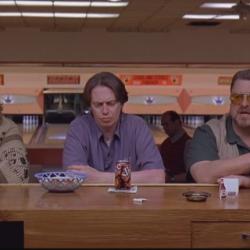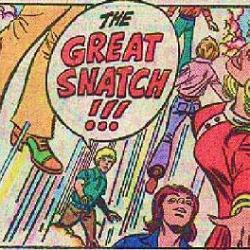Tribulation Force, pp. 1-401
I neglected to mention one other rather important thing the authors neglected to mention following their 18-month leap forward in time.
After the unexplained, instantaneous disappearance of every child on earth the whole world would be desperate to know if it would ever again be possible for women to conceive and bear children. There was no word on this question before the time-skip, as only about six weeks or so had elapsed since the Event. But now, 18 months later, the world would have its answer.
Except the authors don’t mention that answer. Nor does it occur to them to have anyone in their story ask the question.
As far as Tim LaHaye and Jerry Jenkins are concerned, this is not a big deal. For them it’s not much of a mystery. The way they see it, the Event was obviously the Rapture, and there’s nothing in their Rapture folklore that would indicate that children could not be conceived and born during the Great Tribulation that follows.
And because they already know that, it doesn’t occur to the authors that this is something the inhabitants of the world of their story wouldn’t already know. Nor does it occur to them that this is something that the readers of their story might be curious about.
And I, for one, am curious about it. The logic of LaHaye’s take on the Rapture and the Great Tribulation would seem to support the idea that more children could be born into this world. If people can be “born again” after LaHaye’s Rapture, then it makes sense to assume that they could be born physically as well. The Rapture, in LaHaye’s mind, is God’s way of sparing the saints and the innocents from the coming wrath, but if Rayford Steele and Buck Williams and the other post-Rapture conversion “Tribulation saints” must then live through (or die in) this period of judgment, then I suppose it’s consistent to have the newly born “Tribulation innocents” have to live through it (or die in it) as well.
The problem is that this undoes LaHaye’s patched-together theodicy — his way of trying to answer the moral objection to his End Times scheme that arises from the idea of a supposedly just and benevolent God pouring out vindictive wrath on a bunch of infants and toddlers. By allowing innocents to be reintroduced to the world of his story, LaHaye reintroduces that objection.
That word “theodicy” is the one theologians use for the biggest question for which they haven’t got a credible answer: the problem of suffering and evil. Briefly, the universe is filled with pain, suffering, death and unrestrained evils. How can such a universe be reconciled with the idea of a Creator who is all-good, all-knowing and all-powerful? This fallen world would seem to suggest that at least one of those attributes is suspect. (No, I do not have a succinct and satisfying solution to this problem either. I think the closest thing we have to a good answer is also the oldest — the story of Job. It has something to do with ostriches.)
That problem is hard enough to wrestle with here in the real world, but it’s much more acute and much thornier in the world of Left Behind. Here in our world, the real world, gravity pulls, flame burns, viruses spread, predators prey and mortals die. That’s how our universe seems to operate and the Almighty has some explaining to do for creating such a place so fraught with pain and suffering. But here, in the reality of our world, our objection and accusation is still a step removed. We object that the universe works the way it does and we question why its Creator couldn’t have put that omniscience and omnipotence to work creating a universe less prone to grinding us in its gears. If the long arc of our universe bends toward justice, it bends too gradually and too slowly.
But in the fictional world of Left Behind, and particularly in this setting of the Great Tribulation, the grievance is much more direct and immediate. In this story, God deliberately and intentionally intervenes for the explicit purpose of causing human suffering. In this story, evil and suffering are miraculous — with LaHaye’s God violating the laws of the universe in order to inflict ever-more extreme forms of pain and death on humans and other creatures. The calamities and injustices that befall the innocents in this story all come directly, deliberately and gleefully from the hand of LaHaye’s God. The universe of Left Behind does not bend toward justice, it is simply bent — twisted, warped and cruel.
LaHaye’s initial attempt to address — or to disguise — that problem was to whisk all the children off to Heaven. Take away all the innocents and the relentless wrath of his petulant God at least seems a bit less indiscriminate. He can reassure his readers that this absence of children means that everyone left on Earth deserves the torment and pain about to be inflicted on them by the hand of God. The absence of children allows him to portray the coming litany of death as a kind of justice.
That never quite worked in the first place. For one thing, children are not the only unaccountable innocents in the world. Should we not be concerned as well with the many people who do not know their right hand from their left, and also many animals?
But here we are 18 months into the Great Tribulation. The authors have skipped past the calm before the storm because it is the storm itself that fascinates them. All Hell is about to break loose. Wait, no, scratch that. In this story, the source of all this pain and suffering is not Hell. In this story all Heaven is about to break loose, battering humanity and the rest of creation with earthquakes, hail, famine, pestilence, demon locusts, a supernaturally fiery sun and worse. (In this story, there’s nothing scary about “the valley of the shadow of death,” but “thou art with me” becomes terrifying.)
And by the time all this divine brutality gets started, “18 months later,” the entire world is in the middle of the biggest baby boom of all time. The rapturing away of all the innocent children may as well never have happened, because the trials of LaHaye’s Tribulation are about to be poured out on a world filled with infants.
When it comes to massacring innocents, LaHaye’s God makes Pharaoh and Herod look like a couple of amateurs.
The ultimate status of these children in the universe of Left Behind is a bit strange. The authors have already established their rule of an “age of accountability,” which they’ve set roughly around puberty. Anyone below that age, the authors say, is not culpable for their sins. After the Rapture, there’s only roughly seven years left before the End of the World, so none of the children born post-Event will reach an age much beyond 6.
So the good news for these Tribulation innocents is that none of them will live long enough to eventually be condemned to an eternity in Hell. The bad news is that most of them will be killed in the various divine calamities to come, and the few that somehow survive throughout this poor, nasty, brutish and short span will then have to watch as their parents and most of the adults they know are cast into Hell before their very eyes.
These post-Rapture children are the focus of some of my favorite stories at Right Behind — the fiction site created and written by many of the fine folks who regularly comment here. That collection of stories — some hilarious, some haunting, some moving — arose as an inevitable consequence of the Left Behind books themselves, whose maddeningly incurious authors constantly create inadvertent conflicts and conundrums that they never explore or, as in the case of these post-Rapture children, never even acknowledge. Such situations are the raw material of stories but LaHaye and Jenkins couldn’t be bothered to tell them. They were too distracted by phone calls, status symbols and a prophecy check list that prevents either the authors or their readers from ever wondering what happens next.
Within the story of Left Behind, and here in the pages of Tribulation Force as we try to work our way through it, our unavoidable questions about these children, or about the billions of eerily not-grieving parents in the suddenly childless world after the Event, are a constant distraction that prevents us from getting anywhere in the book itself. The only way to make any progress through the book is to come to some kind of accommodation with the authors’ callous disregard for the massive, heartbreaking suffering ceaselessly unfolding at the periphery of their bland and uninteresting story.
We begin by shouting in protest during our supposed heroes’ first heedless stroll across a tarmac strewn with the dead and the dying. Rayford and Buck tiptoe through the burnt and bloody bodies of the wounded without a second glance and we recoil in horror at their self-centered, self-absorbed monstrosity.
Then we learn about the children and the horror of multiple plane crashes is supplanted by a deeper, pervasive horror that touches every corner of the world the authors have created. Every child is gone. Every boy and girl, every toddler, every infant and even every unborn fetus still in utero. The authors paused to acknowledge that last case, very briefly, but only to try to score points about the politics of abortion. Once they made that point, they lost all interest in the implications of that horror as well. The infants, toddlers and other children did not offer the pretext for such political point-scoring, so their disappearance scarcely registered at all for the authors or their protagonists.
Readers, however, are doubly shocked. Shocked first by the massive anguish that this suddenly childless world would entail. Then shocked again by the oblivious selfishness of the main characters and the authors. “For goodness’ sake,” readers shout. “What about the children?”
And we could go on shouting that after every chapter, every page and every paragraph of every book in this series. That protest never ceases to be necessary and appropriate. But we can’t keep it up if we ever want to get anywhere in the book. We don’t have to approve of the authors’/heroes’ careless disregard for everyone else, but we have to agree at least to stop shouting back at the page and to accept that this is who they are and this is the story they’re trying to tell.
The danger there, of course, is that if we stop shouting — even reluctantly, just to get on with the story — then we begin in a sense to emulate Rayford and Buck and the authors. We agree to ignore what they’re ignoring and, thus, we risk developing the habit of doing so.
This is the insidious moral lesson being taught to readers of Tribulation Force. It is a monstrous and horrifying lesson, and unless readers are very careful, they are in danger of learning it.
In The Great Gatsby, F. Scott Fitzgerald wrote about people like Rayford and Buck, or like LaHaye and Jenkins:
They were careless people, Tom and Daisy — they smashed up things and creatures and then retreated back into their money or their vast carelessness, or whatever it was that kept them together, and let other people clean up the mess they had made. …
Fitzgerald, too, was teaching a lesson, but where he was condemning such “vast carelessness” and urging his readers to reject it, that same vast carelessness and destructive disregard for other people are held up as exemplary in the pages of Tribulation Force.
In the following pages, the authors fill us in on all the exciting evangelistic developments that occurred during the 18-month time skip. Tsion, Moses and Elijah have been packing stadiums all over the world. The authors tell us that their message is enthusiastically received, bringing them huge numbers of new converts.
Here we see another way that the authors’ and heroes’ utter lack of curiosity and lack of concern for others influences the story, because the authors don’t ever really tell us what that message is. The prophecy check list says that the witnesses will preach and thousands will convert, so that is what happens in the story. Yet the authors cannot imagine what message these preachers might preach that would strike so many thousands as compelling. Trying to imagine that would involve trying to imagine what other people are thinking, trying to think of them as real people, as human beings worthy of attention and care. And that’s not really something that interests these authors.
So they present us with a scenario in which Tsion is somehow drawing standing-room-only stadium crowds with a warmed-over version of the same “research findings” he presented on his TV show. Not possible.
This is where even one minute of thought about all those missing children could have helped the authors out of a bind. Announce that former rabbi Tsion Ben-Judah will be summarizing his research of ancient texts and you couldn’t realistically expect to sell out the local fire hall. But announce instead that for the first time the public will be told the truth about what really happened to their children and the stadiums would be filled to overflowing.












